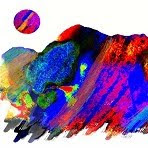The simple answer is that 'dichroic' is defined as the property of having more than one colour, especially when viewed from different angles or in varying degrees of light. This term is frequently used incorrectly, even in the scientific literature. There are two common uses for the term:
(1)Dichroic glass has the appearance of different colours when it is viewed from different angles in white light. There are very early examples of this, for example Chinese glass which in transmitted and reflected light takes different colours. Another is the Roman Lycurgus Cup - see below.
(2)Dichroic glass is the term applied to glass coated with thin layers of metallic oxides which transmit certain wavelengths of light and reflect others. This causes a sparkling rather than a truly iridescent effect which changes with the angle of observation.
Many dichroic glass designers will tell you that it was invented by Nasa and although that is partly true, it is not strictly correct, as this is a only a type of dichroic glass.
The better way of phrasing it is that Nasa developed the technology to manufacture a certain type of dichroic glass and this technique is now used to mass produce sheets of glass, making them accessible and affordable to those working and designing with glass. Although, this method was in fact first invented over 100 years ago and then developed by the space industry.
So going back to the fact that 'dichroic' simply refers to having more than one colour, the earliest complete example of this glass dates back to at least the 4th century AD as seen in the Lycurgus cup, a Roman glass beaker in the British Museum.
The glass cup, which dates from the fourth century A.D., is opaque green which turns to a glowing translucent red when light is shone through it. The glass contains tiny amounts of colloidal gold and silver, which give it these unusual optical properties.
There are further examples of Roman dichroic glass that have been discovered but as yet no-one seems to have come up with an explanation of how they achieved this effect. If you want to read more about the Lycurgus Cup I would recommend reading this research article http://www.goldbulletin.org/assets/file/goldbulletin/downloads/Lycurgus_4_40.pdf.
The technology used to produce dichroic glass now widely used by glass workers and jewellery designers was in part developed by NASA for use as face plates for space suits and space vehicles, which needed transparent mediums which filtered out unwanted light spectrums such as harmful infrared or ultraviolet rays.
Dichroic glass used in my designs contains multiple micro-layers of metal oxides and quartz crystal (these thin layers of oxides have a total thickness of three to five millionths of an inch) which give the glass the ability to show two different colours when looking at it from different angles. It also appears very sparkly and vibrant when viewed up close.
With the play of light, together with its vibrant colour, dichroic glass is a perfect medium for creating beautiful and unusual pieces of jewellery.These are examples of sheets of dichroic glass prior to them being fired in a kiln.
Working with dichroic glass can be challenging as you often get unexpected results once the glass is fired. Depending on what colours and textures you layer together, which way the glass faces and even which part of the kiln you heat the glass in can affect the end result. It is no wonder that throughout history different civilisations have found ways of developing their own forms of dichroic glass as the results, even when unexpected, are always interesting and beautiful.






very interesting thanks for sharing
ReplyDeleteI'm glad you found this interesting, although it was hard to provide a simple explanation of a very scientific subject! There is so much more I could have added but didn't want to bore people to tears too much :)
ReplyDeleteI make wire wrap sea glass & sea shell jewelry, and I wish to expand my hobby into dichroic & other fused glass work.
ReplyDeleteMy problem: Finding comprehensive instructional material finding for guidance in getting started. Can you supply such a publication - or publications? If not, can you recommend some titles? One will do if it is comprehensive. I am a mechanical engineer (BS/ME, circa 1961) so, hopefully, I'll be capable of handling basics & theory just fine.
I am: David Timm // maddave@mac.com // Chesapeake, Virginia, USA